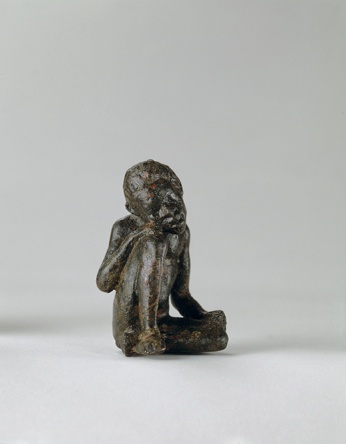
Bronze
H: 5.04 cm
Provenance: no indication
Alexandrian
2nd-1st century B.C.
Solid-cast by the lost wax process and worked in the cold. Originally an element [1] was inserted on top of the head, of which only a small knob remains.
Condition: patina dark green with cuprite here and there, the surface in places scraped down to the underlying brownish metal. The whole considerably worn and with earth deposits.
This Negro youth, an Ethiopian slave or servant, is shown squatting in a position that harks back to a type found throughout the Greek world. It originated in the early 5th century B.C. and carried on through Roman times [2]. His most attractive antecedent is the magnificent sleeping youth in bronze said to be from Dodona in Vienna [3]. His body is relaxed, but the curls of his hair, the thick lips and the broad flattened nose are a beautiful stylized rendering of the same Negro features as on our statuette. Early examples in terracotta found at Selinunte were grave goods, those from the Malophoros sanctuary votives [4]. There are others from Rhodes, at Lindos [5] and Camiros [6]. The motif appears on gems [7] of the second half of the 5th century, and in a bronze statuette [8] which was the finial of a candelabrum from Vulci. Usually said to be sleeping: weary of waiting and sometimes shown in Hellenistic art with a lamp at his side to accompany his master home.
A close parallel for the position and size is the statuette in Copenhagen [9]. His back is more curved, his left hand rests on the ground and the right side of his face leans against his hand above the knee. On our example, the back is far straighter, the hand is on his lower left thigh and the head turned also more erect, rests on its lower right cheek. These variations denote different purposes: the Copenhagen example surely surmounted a vessel, possibly the finial of a candelabrum, whereas here, the little knob on top of the head, the remains of a broken hooked rod, would have enabled use as a steelyard weight. Thus the need for a more compact vertical construction.
His style suggests a late Hellenistic date and his patina is typical for Egyptian bronzes.
1 Either a rivet to enable fixing to a plate or tray, or a rod that ended in a hook.
2 Hadzisteliou-Price, T.: The Type of the Crouching Child and the Temple Boys, BSA 64, 1969, p. 103.
3 Kunsthistorisches Museum, Antikenabteilung VI 2551: Gschwantler, K. et al.: Guss + Form. Bronzen aus der Antikensammlung (Vienna, 1986), no. 66, p. 70 ("Greek, second quarter 5th century B.C. H: 4 cm").
4 Simon, E. (ed.): Die Sammlung Kiseleff im Martin-von-Wagner-Museum der Universität Würzburg. Teil II. Minoische und griechische Antiken (Mainz, 1989), no. 265, pp. 165-166, pl. 103.
5 Blinkenberg, C.: Lindos I. Les petits objets (Berlin, 1931), no. 2384, p. 577, pl. 112.
6 Higgins, R.A.: Catalogue of the Terracottas in the Department of Greek and Roman Antiquities, British Museum, I (London, 1954), nos. 261, 262, 268, pp. 94-95, pl. 45-46.
7 Berlin, Antikenmuseum FG 347: Zwierlein-Diehl, E.: Antike Gemmen in deutschen Sammlungen, II Berlin (Munich, 1969), no. 160, p. 75, pl. 36.
8 On the market in 1991. Another similar figurine, but not a Negro, in Hafner, G.: Die Bronzen der Sammlung Dr. Heinrich Scheufelen in Oberlenningen. Ehemalige Sammlung des Prinzen Christian August von Waldeck in Arolsen (Mainz, 1958), no. 38 (450), p. 11, pl. IV.
9 Ny Carlsberg Glyptotek 2755: Poulsen, F.: Catalogue of Ancient Sculpture in the Ny Carlsberg Glyptotek (Copenhagen, 1951), Br. 16, p. 609; Ny Carlsberg Glyptotek. Billedtavler til Kataloget over Antike Kunstvaerker (2nd plate suppl., Copenhagen, 1941), pl. XVII.